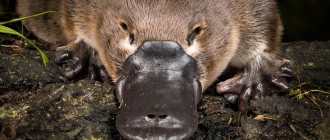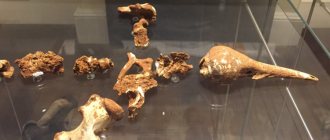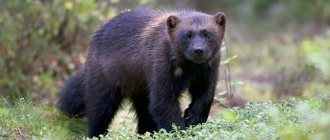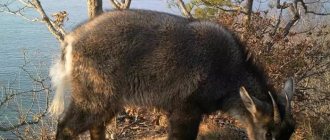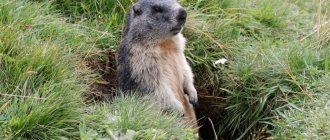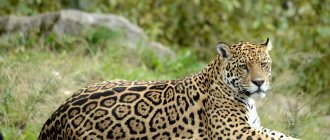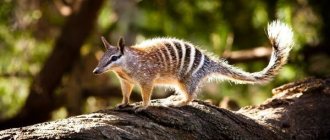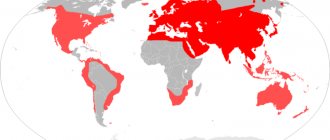The platypus is an amazing animal that has become a symbol of Australia, photos of which can be found in almost every corner of the country. They even have a coin issued with his image.
This unusual animal is the only representative in its family and belongs to waterfowl mammals. The platypus is part of the order of monotremes, to which, in addition to it, the echidna also belongs. Only they have such a distinctive feature as the entry of the urogenital sinus and intestines into the cloaca, and not exiting through separate passages, as is the case with other representatives of the animal world.
Appearance and description
The body of the animal is knitted and dense with thick dark brown fur, very pleasant to the touch. Only on the belly can a shade of red or gray predominate. The head itself is round in shape. The mammal's nose, ears and eyes are located in special recesses that close tightly when diving.
The platypus is not large in size. The total length of the entire body does not exceed 40 cm, although males are 10-15 cm longer. It is worth considering that only the tail of the animal is approximately 15 cm long, and the total weight is 2 kg.
Its legs are located on the sides, so its gait is unusually similar to the movements of reptiles on the ground. Each paw has five toes, between which there is a connecting membrane. Its paws help it not only swim well, but also quickly plow the ground, thanks to the membrane that turns the limb from an oar into a shovel. True, the membranes are not well developed on all paws, but only on the front ones, so when swimming the animal actively uses them. At this time, the hind legs assume the steering role.
The tail of the platypus is flat-shaped, covered with hair, and reserves of fat are accumulated and stored under the skin. It is this limb that helps the mammal maintain balance when swimming. The approximate age of the animal is also determined by the tail, depending on the amount of fur on it. If the cover is sparse, then the animal is already adult.
In terms of external characteristics, male platypuses differ from female ones.
Social structure and reproduction
Photo: Baby platypus
The mating season for platypuses begins in August and lasts until the end of October and mid-November. Females attract individuals of the opposite sex by wagging their tail. During this period, males come to the territory of females. For some time they smoothly follow each other in a kind of dance. Then the male begins to pull the female by the tail. This is a kind of courtship that lasts a very short period of time.
After mating and fertilization, females build a home for themselves, in which they subsequently give birth to offspring. Such a hole differs from the standard home of animals. It is somewhat longer, and at the very end is the female's nest. The female lines the bottom with leaves, to collect which she uses her tail, with which she rakes it into a pile. After construction and arrangement is completed, the female blocks all the corridors with earth. This is a way to protect against flooding and attacks from dangerous predators.
After this, she lays one to three eggs. Outwardly, they look like reptile eggs. They have a grayish tint and a leathery shell. After laying eggs, the expectant mother constantly nourishes them with her warmth until the moment when the cubs are born. The offspring hatch ten days after the female laid her eggs. The cubs are born tiny, blind and without hair. Their size does not exceed 3 cm. Babies are typically born through an egg tooth, designed to pierce the shell. Then it falls out as unnecessary.
After birth, the mother places the babies on her stomach and feeds them with her milk. Females have no nipples. They have pores in the abdomen through which milk is secreted. The cubs simply lick it off. The female is with her babies almost all the time. It comes out of the hole only to get food for itself.
After 10 weeks from birth, the baby’s body becomes covered with hair and their eyes open. The first hunt and experience of independent food production appears at 3.5-4 months. After a year, young individuals lead an independent lifestyle. The average life expectancy in natural conditions is not precisely determined. Zoologists suggest that it is 10-15 years.
Distinctive features
Female:
- Body length: 40 cm.
- Weight of an adult animal: 2 kg.
- Animal tail: 15cm.
- Presence of spurs on the hind legs: present at birth, disappear as they grow older
- Poison: Toxic saliva.
Male:
- Body length: 50-60 cm.
- The weight of an adult animal is 2.5-3 kg.
- The animal's tail is 20 cm.
- Presence of spurs on hind legs: present throughout life.
- Poison: Toxic saliva and poisonous spurs.
Why is the platypus poisonous?
Poisonous Spur
Unlike fish and reptiles, among which poisonousness is often found, mammals use sharp claws and teeth, powerful tusks or horns to protect and capture prey. The platypus is one of the few animals capable of producing poison and injecting it into an attacker or victim. To do this, it uses poisonous spines located on its hind legs.
Venom gland
The spines resemble the spurs of birds in appearance. They are noticeable in newly hatched cubs of both sexes, but as females grow older, the spurs stop developing and atrophy. In adult males, each spur is connected by a duct to the sacral gland, in which poison is produced. Toxic substances are formed especially intensively during the mating period of platypuses.
When defending or attacking, the platypus strikes with its hind paw, driving the spine as deep as possible, and injects poison. The toxic substance is a mixture of almost 20 different components. Moreover, it contains more effective D-toxins, while most poisonous species contain relatively weak L-toxins.
The poison that enters the body of a small animal acts on the heart, causing it to stop. There are known cases of deaths of dogs used by hunters to catch animals. Platypus venom is not fatal to large animals and humans, but it can cause significant harm to health. So, after an animal attack, extensive swelling forms at the site of the impact and quite severe pain appears. People who have survived a platypus attack report that the damaged limb becomes more sensitive to pain, and they also experience limited mobility during physical activity.
Beak
The most interesting thing about the platypus's appearance is its beak. It looks wide and flat, as is typical for ducks, but differs from them in its softness and flexibility. It is 65 mm long and about 50 mm wide. The outside of the beak has elastic skin that contains many nerve endings. Thanks to them, the animal has an excellent sense of smell, which helps it sense the weakest muscle contractions, even in crayfish.
Being in an aquatic environment, the platypus is unable to see or hear anything, and this ability helps it hunt and get food. It is for this purpose that in the water space he constantly turns his head.
Platypus poison
The platypus is one of the few mammals capable of producing venom. All representatives of this species have toxic saliva. Males, in turn, still possess a toxic substance that is located in the horny spurs. All young individuals have poisonous spurs, but as they grow older, the females lose them.
The toxic substance is not fatal to humans, but will leave a serious burn on the skin. A swelling will form at the puncture site, which will go away after a few weeks, but the pain may persist for several months.
The animal has few enemies in the animal fauna, but leopard seals, monitor lizards, and pythons will not refuse its meat. It was for defense against them that nature endowed the platypus with a toxic substance. The toxin is produced by a gland located on the hips, which connects to the spurs through a small duct. The venom becomes especially powerful during the breeding season and is capable of killing any medium-sized animal.
Nutrition
The daily diet of this amazing animal includes various organisms: small aquatic animals, worms, larvae, tadpoles, mollusks, crustaceans. The platypus stirs up the bottom with its paws and beak - it collects the rising living creatures in its cheek pouches. In addition to the living inhabitants of the reservoir, aquatic vegetation also gets there.
On land, all prey is crushed by horny jaws. In general, the platypus, an unpretentious eater, only needs a sufficient amount of food. He is an excellent swimmer who, with good speed and maneuverability, is able to collect the required number of edible organisms thanks to electrolocation.
Particular gluttony is observed in females during lactation. There are examples where a female platypus ate a volume of food equal to her weight per day.
Kinds
The platypus has been studied by zoologists for a long time in attempts to determine the group to which this species of animal can be attributed. They studied the structure of his body, habits, lifestyle, method of reproduction and feeding of offspring. As a result, he was assigned to the platypus family, where he became the only representative of his genus.
Even the animal had little resemblance to its closest relatives, the echidna and the echidna, but together they formed a detachment of monotremes. Similarities with reptiles in the manner of laying eggs were also revealed. Then it became known that the animal feeds its offspring with milk, after which it was decided to classify it as a mammal.
Who are platypus
These amazing animals are waterfowl mammals, the only representatives of the platypus family that belong to the order Monotremes. This order is noteworthy in that it includes the echidna, platypus and echidna, and the main feature of its representatives is that the urogenital sinus and intestines of animals do not exit through separate passages, but flow into the cloaca.
The platypus lives in eastern Australia, on Kangaroo Island and in Tasmania, which is 240 km from the Australian coast towards Antarctica. It prefers to live in fresh water, the temperature of which ranges from 25 to 29.9°C.
Koalas are the original representatives of the living world of Australia112344.811
Previously, this animal could be found throughout the continent, but many of them were exterminated by poachers, and the remaining animals, due to too much environmental pollution, moved to more environmentally friendly regions.
Peculiarities
The platypus, with its varied structures, still surprises many scientists. Looking at individual parts of the body, one can presumably attribute the animal to various types of animal fauna:
- the beak speaks of family ties with the duck;
- the tail can be compared to the beaver family;
- the fur resembles that of a bear;
- webbed paws are more related to an otter;
- the claws are very reptile-like.
It is the only venomous animal in existence with a body covered in fur. Its venom is as powerful as that of the most dangerous snakes.
It is also unusual that the platypus feeds its offspring with milk, despite the fact that it only has special holes on its body instead of nipples. This fact makes evolutionary classification paradoxical. And the fact of the existence of a chronicle of the fossilized remains of an animal only confirms the primordial nature of this creature, which has not undergone evolution. This is confirmed by the following facts:
- The remains are absolutely identical to those forms that are characteristic of the beast at the present time.
- The mammary glands and egg structures were and are fully developed. The origin of the uterus and its further development cannot be explained.
- All other mammals were found in lower layers than those where the platypus remains were found.
- Not a single evolutionist is able to explain the anatomical features of a mammal, as well as the physiological ones. Most of its signs can be found in amphibians, birds, and many animals.
- The platypus can be found most often in the water, because it spends most of its time swimming and diving. During the day he rests near the river in a hole that he dug himself. Sometimes the animal goes into real hibernation, in which it can stay for up to 10 days. This indicates that the mating season is approaching, and he just needs to gain strength.
- Throughout its life, the platypus lives alone and even the appearance of offspring does not contribute to the creation of pairs, because the female takes on all the responsibilities of feeding and raising.
Much can be said about the tail of an animal, which is used for the following purposes:
- to attract males;
- rudder when swimming and diving;
- place of accumulation and storage of fat;
- self-defense weapon;
- a shovel for collecting vegetation in a hole;
- a kind of door to close the entrance to a home.
What does the platypus eat?
Photo: Platypus in the water
Platypuses are excellent swimmers and divers. To do this they need a large amount of energy. The daily volume of food must be at least 30% of the animal’s body weight in order to cover energy costs.
What is included in the platypus diet:
- shellfish;
- seaweed;
- crustaceans;
- tadpoles;
- small fish;
- insect larvae;
- worms.
While in the water, platypuses collect food in the cheek space. Having got out, they grind the food they have obtained with the help of horny jaws. Platypuses tend to instantly grab the victim and send it to the cheek area.
Aquatic vegetation can serve as a source of nutrition only if difficulties arise with other food sources. But this happens extremely rarely. Platypuses are considered excellent hunters. They are able to turn over stones with their nose, and also feel confident in muddy, silt-filled water.
Body structure (anatomical features of the platypus)
Particular attention is paid to the nose, which looks more like a beak. It consists of arched bones connected to each other and covered with skin. Younger individuals even have teeth, although they gradually wear out.
Nature was clearly preparing this animal for swimming. It has eyes, ears, which are covered with skin when diving, and a special valve closes its nose. The platypus is not able to use any of these organs while in water.
On the beak, in the skin, there are nerve endings that help the animal use electrolocation. With the help of his nose, he picks up the weakest electrical radiation. This is how he recognizes prey, which is why he turns his head so often when swimming.
The paws of a mammal are created in such a way that with their help it can both swim and dig the ground. Between the fingers on his limbs there is a membrane, thanks to which he is recognized as an excellent swimmer. And when he needs to dig up something, the membrane miraculously folds, giving way to claws, turning the animal’s paw into a kind of shovel.
The platypus is also surprising in the location of its paws on both sides, on the sides, and not below the body, which is similar to the structure of reptiles. This explains its special movement on the ground.
The mammal can independently monitor its body temperature and maintain it. In normal conditions, it does not fall below 32 degrees, and while swimming in cold water, the animal is able to retain heat and prevent cooling.
Lifestyle and habits
These amazing creatures lead a solitary lifestyle. Platypuses settle on the banks of lowland rivers, near standing natural reservoirs, and can also set up their homes in the coastal zones of mountain streams. Both males and females have a small personal territory, including a refuge burrow and underwater hunting grounds.
Platypuses live exclusively in fresh water; they avoid salt lakes and lagoons. The animals feel more comfortable in warm bodies of water, where the water temperature does not drop below +25 degrees. But thanks to the peculiarities of their metabolism, they are able to live in cool high-mountain springs, where the water temperature fluctuates between 5-10 degrees above zero.
Lifestyle of the platypus
Platypuses are active in the evening and at night. The animal spends almost the entire night (10-12 hours) in the water, obtaining food for itself. Platypuses are natural swimmers and divers and can stay underwater for up to 5 minutes. In search of food, the animals deftly maneuver among underwater snags and tangles of algae, focusing on electromagnetic pulses generated by the movement of aquatic inhabitants. During the swim, the platypus makes wide strokes with its front paws, uses its hind limbs as a rudder, and its tail serves to stabilize and coordinate the body.
The platypus is just a natural swimmer
In the morning, after a successful hunt, the well-fed platypus returns to its home, where it will spend the whole day resting and sleeping. The burrows of these creatures are located near the shore, and their depth can reach 8-10 meters. Platypuses are unpretentious in terms of living conditions, and do not build luxurious mansions with many rooms. Their lair consists of only one chamber, where the animals themselves sleep, and have two exits: one is located on land, and the other is under water, and is disguised by algae or tree roots.
Interestingly, after hunting at night, the platypus enters its shelter through an underwater passage, which is so narrow that by squeezing inside, the animal literally squeezes its coat out of the water, so that its burrow always remains dry and cozy.
Character and behavior
These are very distrustful, cautious and shy creatures. Platypuses can be called real four-legged introverts, they are so secretive and uncommunicative. Platypuses are not at all characterized by aggression and hostility, they simply prefer a hermit lifestyle, and they like this solitary, reclusive existence. The animals have virtually no contact even with their relatives, and only meet each other during the mating season.
The shy and timid platypus always hides from prying eyes
Platypuses are also extremely timid and fearful. The slightest suspicious noise near their burrow is enough for the animal to fall into a state of stupor and stress. And as soon as a platypus smells the smell of another animal near its home, this is a good reason for it to leave its hole forever and go in search of a place to build a new shelter. By the way, feral rabbits brought to Australia by European settlers cause a lot of trouble for platypuses. Fluffy rodents populate coastal areas in large colonies, where platypuses have lived for centuries, and they are forced to leave their original habitats and move to the banks of other rivers, away from their unceremonious neighbors.
In water, platypuses are silent, but when disturbed on land, they make very strange sounds, simultaneously reminiscent of the displeased clucking of an angry hen and the grumbling of a small puppy.
Poll: would you like to hold a platypus?
Yes, they are so cute and fluffy.
30%
Yes, I would like to get to know such an interesting animal better.
50%
No, probably their strange appearance scares me.
0%
No, of course not, because platypuses are very poisonous
20%
Voted: 10
Habitat and behavioral characteristics, lifestyle
The only continent where you can find the platypus is Australia. It lives near lakes and rivers, tropical lagoons. The swamps and swamps of Eastern Australia became a special paradise for him. It prefers to live in fresh water and cannot tolerate dirt and salt. The mammal loves warmth, but despite this it can also settle in high mountain streams, where the water temperature is quite cold. This is due to its ability to regulate its body temperature. Even in five-degree water, you can easily swim for several hours.
On the shore, the platypus will definitely dig a hole for itself, up to 10 m long. There are always two entrances to its home, one of which leads straight into the water, and the other will be hidden in the roots of trees. The entrance to the hole is very narrow, which allows it to remove excess liquid from the fur when returning home.
Where does the platypus live?
Photo: Platypuses echidna
Until the 20s of this century, animals lived exclusively in Australia. Today, animal populations are concentrated from the Tasmanian possessions through the Australian Alps, right up to the outskirts of Queensland. The bulk of representatives of the platypus family is concentrated in Australia and Tasmania.
The mammal leads a hidden lifestyle. They tend to inhabit the coastal areas of water bodies. It is typical that they choose only fresh water bodies for living. Platypuses prefer a certain water temperature – from 24 to 30 degrees. Animals build burrows for living. They are not long, straight moves. The length of one hole does not exceed ten meters.
Each of them has two entrances and a furnished room. One entrance is accessible from land, the second from a reservoir. Those who want to see the platypus in person can visit the zoo or national reserve in Melbourne, Australia.
Platypus feeding
The platypus begins hunting in the late evening and almost all the time it swims in search of food. This is not an easy job, because per day he needs to absorb 1/4 of his total weight. If the prey has been spotted, then it is unlikely to be able to escape the chase, because the animal takes off like a bullet. A few seconds are enough for a hungry platypus to feast on it.
The platypus has special cheek pouches in which it stores the food it catches. Having collected enough food, it comes to the surface, where it begins to grind the food. To do this, he uses horny plates instead of teeth.
Mammal diet:
- crustaceans;
- insects;
- frogs and snails;
- worms;
- small fish;
- seaweed.
Do not think that he hunts exclusively in water. The animal also searches for food on land, turning over stones with the help of its claws and beak.
Natural enemies of platypuses
Platypuses do not have many enemies, although monitor lizards, pythons and leopard seals that swim into rivers can easily cope with platypuses. In fact, platypuses are considered poisonous mammals because they are armed with poisonous spurs located on their hind legs.
Interesting to know! To catch the platypus, dogs were used, which easily caught these mammals, both in water and on land. Unfortunately, many of them died from the poison when the platypuses defended themselves using their poisonous spurs.
After reaching the age of puberty, females lose such weapons of defense, and males, on the contrary, become more dangerous as the spurs increase in size. Males use them both during the mating season, arranging fights, and defending themselves from natural enemies. This poison does not pose much danger to humans, but can cause allergic reactions.
Baby platypus
The baby platypus is born blind, completely bald and does not exceed 2.5 cm in length. To get out of the egg, it uses an egg tooth, which immediately falls off. With this tooth, the baby breaks through the shell to get out. The female immediately takes the babies and places them on her belly.
The mother stays close to the children all the time and only goes out to dry the fur and hunt. Leaving the hole, she closes the entrance with an earthen plug.
On the 11th day, the babies' eyes begin to open, but they are in no hurry to part with their mother and live with her for up to 4 months. While the children are nearby, the female continues to feed them.
The offspring are born with teeth, but after stopping milk feeding, they disappear. At 17 weeks of age, they begin to become familiar with hunting and emerge from the burrow. By this time, the cubs reach 33 cm, their body is already covered with hair.
The offspring of the platypus are considered sexually mature only after reaching the age of 1 year.
Reproduction and raising of offspring
Platypuses become sexually mature when they reach 1-1.5 years. The breeding season for these animals is only once a year, and lasts from late August to November.
Before the mating season itself, platypuses fall into a kind of hibernation, lasting for 10-14 days. Scientists have not yet figured out the meaning of short sleep, and are inclined to believe that in this way the animals gain strength before the upcoming mating games.
Mating season
When the time comes for breeding, male platypus change their bachelor habits and begin to invade the personal territories of females. Moreover, several duck-billed gentlemen are vying for one lady at once. And in order to win the favor of the female, males have to organize something like knightly tournaments, where victory goes to the strongest and bravest. Usually quiet and timid males become aggressive and decisive during the mating season. And since they do not have claws or teeth, they fight among themselves, using their only weapon: spurs filled with poison.
Researchers have not yet been able to determine how platypus venom affects the platypuses themselves. Only one thing is clear - animals do not die from it. But the injections from the enemy’s spur received in the fight for the female are most likely painful, which forces some males to admit defeat and quickly retreat from the battlefield.
The male must prove to the female that he is the one worthy to become the father of her future children.
But victory over other rivals for the male is only half the way. After all, he still has to win the favor of his chosen one. And female platypuses are very capricious and capricious, and try by all means to avoid meeting their suitor. The ardent lover has to follow the lady for several hours, and they swim in a circle, performing a ritual dance. At the right moment, the male swims up to the female and bites her tail, after which she accepts his advances and mating finally occurs between them.
Upon completion of the love act, the male goes in search of another partner. The male representatives are not at all interested in the fate of their own cubs, and all care for the future offspring falls on the shoulders of the females.
Relationships with people
At the beginning of the last century, these amazing animals were on the verge of extinction. Australian poachers were decimating the population in pursuit of their valuable fluffy fur. To make one fur coat, about 60 skins of defenseless animals were required. Fortunately, a ban on catching these animals was introduced, which helped save them from complete destruction.
Nowadays the population is safe. The platypus can rightfully be considered an indigenous resident of Australia, who does not want to change his place of residence to any other continent. For this, local residents have recognized the animal as a symbol of the country and protect it as much as possible from poachers.
Population status and conservation
The platypus' amazing fur has made them a tempting target for poachers. The species was in danger of extinction, after which Australian naturalists sounded the alarm. Special reserves began to be created throughout the continent, and the animal found itself under state protection. But the animal turned out to be very sensitive and timid, which required complete protection from the presence of humans nearby.
Also in Australia, rabbits are widespread, which created inconvenience for creating a special environment for the mammal. The fact is that the rabbits brazenly occupied the platypus holes, depriving them of nesting places.
In order to increase the population, the government had to allocate large tracts of land, completely fenced off from external interference. This is the only way to preserve the species of mammal and increase its population.
Afterwards, a decision was made to resettle the animal in the territories of zoos. The first platypus was put in the New York Zoo in 1992, where it could live only 49 days, which again alerted zoologists. But the platypus is a wild animal, and because of its natural timidity, it practically did not show itself to people and was reluctant to reproduce. There is not a single case of taming an animal by man.
The platypus has now been officially removed from its endangered species status. Travel companies have even organized a special route through the mammal’s habitats, but you can only observe it from afar.
Lifestyle and habitat
Platypus populations live in Australia, the islands of Tasmania, and Kunguru in the area of the southern coast of the mainland. The extensive distribution range from Tasmania to Queensland has now shrunk. The animal has completely disappeared from areas of South Australia due to pollution of local waters.
The platypus in Australia inhabits various natural reservoirs and coastal zones of small rivers. The animals' habitat is fresh water with a temperature of 25-30°C. Platypuses avoid brackish waters; they are sensitive to various pollutants.
The animal swims and dives beautifully. Immersion in water lasts up to 5 minutes. Staying in a pond is up to 12 hours a day. The platypus thrives in wetlands, lakes, high mountain streams, and tropical warm rivers.
The semi-aquatic lifestyle is associated with a favorite site - a body of water with a quiet current among thickets on raised banks. Ideal habitat next to a calm river passing through the forest.
Increased activity occurs at night, in the twilight of the morning and evening. This is hunting time, since the need for daily replenishment of food supplies is up to a quarter of the animal’s own weight. During the day, the animals sleep. The platypus searches for prey by turning over stones with its beak or paws, stirring up muddy masses from the bottom.
The animal's burrow, straight, up to 10 meters in length, is the main shelter. The construction of an underground passage necessarily provides an internal chamber for rest and breeding, and two exits. One is located under the roots of trees, in dense thickets at a height of up to 3.6 m above the water level, the other is certainly at the depth of the reservoir. The entrance tunnel is specially designed with a narrow opening to keep water out of the platypus' fur.
In winter, animals hibernate for a short time - 5-10 days in July. The period occurs on the eve of the breeding season. The meaning of hibernation has not yet been reliably established. It is possible that this is the platypus’ need to accumulate vital energy before the mating season.
Endemics of Australia are attached to their habitat, sedentary, and do not move far from their lair. The animals live alone and do not create social connections. Experts call them primitive creatures, not noted for any intelligence.
An extreme degree of caution has been developed. In places where they are not disturbed, platypuses approach the city limits.
Once upon a time, platypuses were exterminated for their beautiful fur, but this fishery object was banned from the beginning of the 20th century. Populations have decreased and the range has become mosaic. Australians are making efforts to protect platypuses in nature reserves. Difficulties arise in the relocation of animals due to their increased fearfulness and excitability.
Breeding in captivity is not successful. It is difficult to find a more alarming mammal than the platypus - what animal is capable of leaving its hole due to any unusual noise? The voice and vibration, unusual for platypuses, knock the animals out of their established rhythm of life for several days, sometimes weeks.
Rabbit breeding in Australia has caused great harm to the platypus population. The rabbits' digging of holes disturbed the sensitive animals and prompted them to leave their usual places. The risk of extinction due to the characteristics of mammals is high. Hunting for it is prohibited, but changes in the habitat have a detrimental effect on the fate of the platypus.
The most interesting facts about platypuses
Here are some more interesting facts about this amazing creation of nature:
- The platypus is the most amazing animal, at the same time similar to a beaver, but at the same time with a duck's beak, paws like a reptile, and fur like a bear.
- Females lay eggs in a manner similar to birds and reptiles.
- They do not have nipples or a brood pouch, so the cubs simply lie on their mother’s belly and lick milk from their fur.
- After mating, the male does not take any part in building the burrow and raising the offspring.
- The mammal can stay underwater for about 5 minutes in one dive. And during the day he spends up to 10 hours swimming.
- When eating food, he does not forget to store fat in his tail.
- The platypus can produce its first offspring at the age of two.
- During the spring breeding season, one female gathers dozens of males around her, who fight with each other for the attention of the female with the help of their poisonous spurs.
- This type of mammal has the slowest metabolism in comparison with other representatives of the animal fauna.
- The first platypus appeared on earth 110 million years ago, immediately after the extinction of the dinosaurs, as evidenced by the fossilized remains found.
- The animal can be found only on one continent - Australia, but it is known that when they appeared they were distributed throughout the land.
- Its beak is soft, and not hard, as it seems. Lips and noses are created from such skin in other animal species.
- Despite the fact that the animal’s beak is soft, it is great at plowing mud at the bottom.
- Underwater, the mammal is helped to navigate by the same beak, the skin of which contains many nerve endings.
- The platypus can be found on the Australian 20 cent coin.
- Today hunting for this animal is completely prohibited, so the animal is completely safe.
Modern zoologists and naturalists have learned to get as close as possible to the platypus in order to get the most valuable photos from the life of the animal. They are happy to publish all successful shots in various magazines, and write their own stories about what they managed to learn new about the habits of the mammal. Images of this amazing beast can be found on the emblems of many Australian companies.
A brief excursion into the history of platypuses
These unusual creatures became a real discovery among scientists, and gave rise to fierce debate in the scientific community. For decades, naturalists have studied platypuses, but have still not been able to solve all their mysteries.
The evolutionary path of the platypus
The order of monotremes, to which platypuses belong, are the first branch of mammals. So these creatures have a very ancient origin, and began to form as a separate species back in the Jurassic period, being contemporaries of dinosaurs.
Platypuses are a very ancient species of animal, and their ancestors lived on earth along with the last dinosaurs
The ancestor of platypuses separated from representatives of marsupials and placentals approximately 145 million years ago. But it took several more tens of millions of years of evolution before their putative ancestor acquired the features of today's platypuses. According to rough estimates of experts, the age of the fossilized remains of the oldest monotreme found in Australia is 110 million years.
The fossil animal that started the platypus lineage was half reptile, half rodent, nocturnal, and gave birth to live but immature young. At what evolutionary stage the ancestors of duck-billed creatures developed the ability to lay eggs is unknown. But already 4.5 million years ago, on the lands of Australia and South America, which were part of the ancient supercontinent Gondwana, there lived an animal whose body structure was almost completely identical to the anatomical features of modern platypuses.
In 1984, a sensational discovery was made in the Australian state of Queensland, which could completely refute the previous history of the evolution of platypuses. Paleontologists have discovered the bones of giant duck-billed animals that lived in Australia approximately 15 million years ago. They differed from modern platypuses only in their larger size and the presence of molars, which suggests that their diet, in addition to invertebrates, included fish and turtles. Scientists have not yet been able to determine whether they are direct ancestors or simply the closest relatives of modern duck-billed animals, but some zoologists already believe that the evolutionary path of these creatures was much more complicated, and further study of the find will prepare many more surprises for the scientific community.
Headache for zoologists
Platypuses lead such a secretive lifestyle that Europeans, who first landed off the coast of Australia in the 17th century, only became acquainted with these amazing creatures 2 centuries later. One of the colonists, while fishing, caught the eye of a strange waterfowl. Naturally, the man decided to study the hitherto unprecedented beast in the most primitive and accessible way - by hitting it with an arrow.
A simple farmer could not determine what kind of prey he came across, and decided to send his find to London. So, in 1797, the first platypus, or rather, its skin, fell into the hands of British scientists. And it immediately became a bone of contention in the scientific community. Zoologists refused to believe in the existence of such an animal and called it a fake, and the timid voices of some experts who believed in the authenticity of the skin were drowned out by the indignant chorus of their authoritative colleagues.
The appearance of the platypus has confounded the greatest scientists
Recommended by topic
Fox Panda Lynx
After 2 years, a strange exhibit fell into the hands of the English naturalist George Shaw. He began to study it in detail, and at first he even cut the skin, looking for stitches, because he also could not believe that it was genuine. But the more Mr. Shaw examined the unusual specimen, the more his doubts dissipated. And finally, the Briton made a stunning announcement: an animal with the body of a beaver, webbed feet and a duck’s beak exists!
Of course, this reignited heated debate among scientists, with some even thinking that George Shaw was crazy. But soon a new gift arrived from Australia, in the form of two platypuses preserved in alcohol, and zoologists had to admit that such strange animals are reality, and not someone’s cruel joke. And the four-legged inhabitants of the Green Continent were preparing new surprises for naturalists. And it took scientists more than a hundred years before they could believe in the existence of an animal that looks like a mammal, but at the same time lays eggs, and even feeds its babies with milk oozing from the internal mammary glands.
Modern history of platypuses
Recognition by people did not bring happiness to the platypuses. Rather, on the contrary, it almost became the reason for their disappearance. After all, the thick fluffy fur of the animals made them the object of hunting, and uncontrolled fishing led to a catastrophic decrease in their numbers. Only at the beginning of the 20th century was hunting for platypuses banned, and naturalists in Australia began to develop a special system of refuges and protected areas where animals could live and reproduce in peace. At the moment, platypuses are relatively safe, but the revival of their population is happening at a slow pace, which is associated with the reduction and pollution of their natural habitat.
